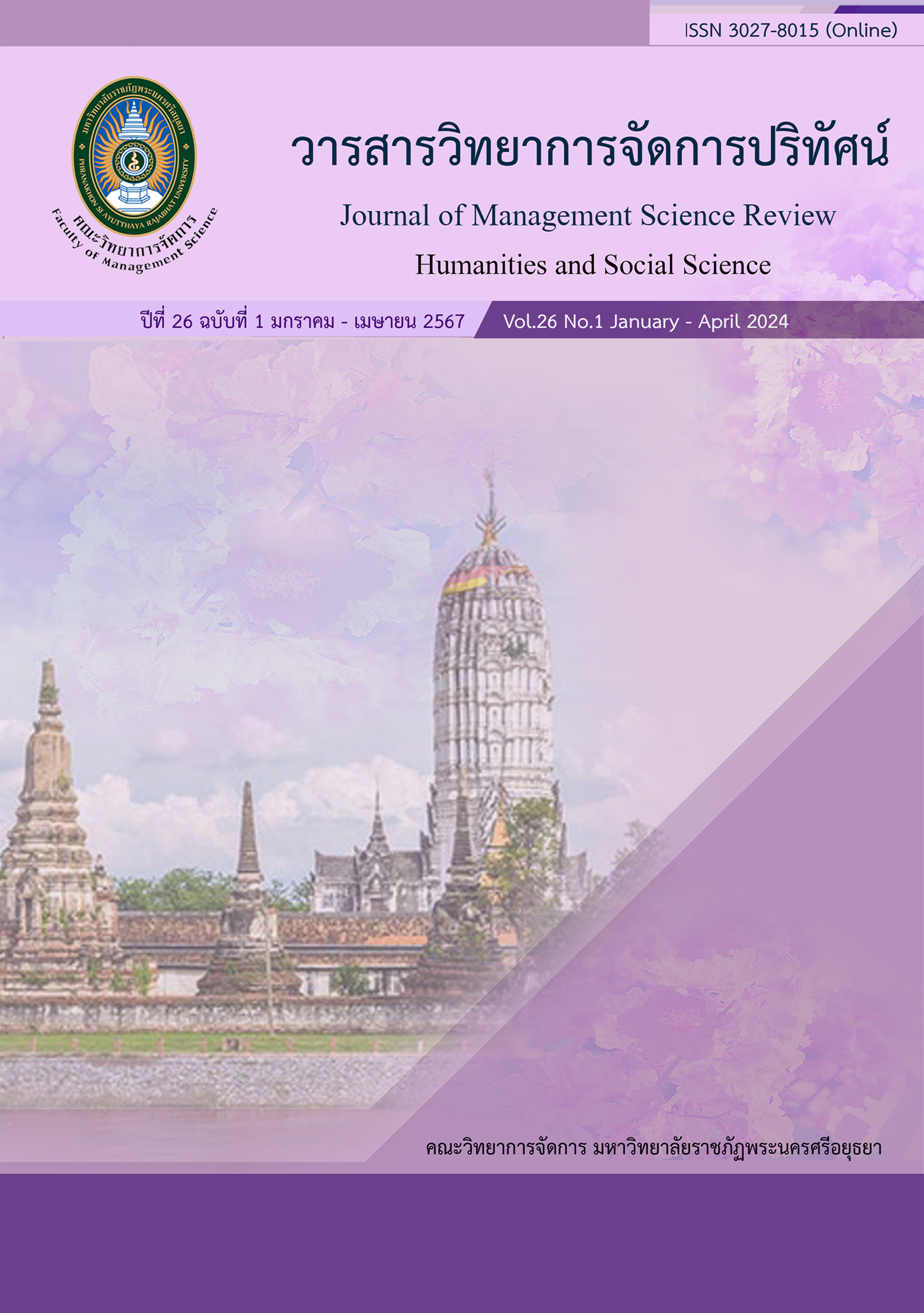Service Marketing Mix Strategy Model for Spa and Thai Massage Businesses In Samut Prakan Province
Keywords:
Strategy Model, Service Marketing Mix, Spa and Thai Massage Businesses, Decision MakingAbstract
This research aimed to 1) to compare the decision-making processes regarding the selection of Thai spa and massage services among consumers, categorized by personal data, 2) to examine service marketing components influencing consumers' decisions to choose Thai spa and massage services, categorized by different decision-making processes among consumer subgroups, and 3) to explore the marketing service mix strategies for Thai spa and massage businesses. The sample consisted of 400 consumers who utilized spa and massage services in Samut Prakan province. Sampling was conducted with a confidence level of .97. Data were analyzed using descriptive statistics, t-tests, ANOVA, and stepwise multiple regression analysis.
The research findings revealed that: 1) Consumers engaged in government or state enterprise occupations, corporate employment, or those unemployed exhibited differing decision-making processes compared to self-employed or freelance individuals. However, no significant differences were observed. 2) Positive influences on decision-making regarding Thai spa and massage services among government employees, corporate employees, and unemployed individuals were attributed to service landscape, distribution/location, product offerings, and processes. Conversely, service providers had negative influences. For self-employed or freelance consumers, positive influences were observed in product offerings, service providers, and pricing. 3) Two distinct marketing service mix strategies were identified for Thai spa and massage businesses.
References
Bangkok Thurakit. (2022). Spa business tends to grow 17% per year after the COVID-19 crisis. Retrieved from https://www.bangkokbiznews.com/social /983284
Chanthanawan, S., & Fongthanakit, R. (2019). Factors affecting decision making on using spa service towards consumers in Chatuchak district, Bangkok. Journal of the Association of Researchers, 24(3), 190-204.
Cochran, W. G. (1953). Sampling Techniques. New York: John Wiley & Sons.
Dhurakij Pundit University. (n.d.). Opening the new era massage-spa model. Retrieved from https:// www.dpu.ac.th/research/8
Hair, J. F., Black, W. C., Babin, B. J., & Anderson, R. E. (2014). Multivariate Data Analysis (17 th ed.). USA: Pearson education.
Kitkasachareon, P., & Boonchai, P. (2018). Research report on the marketing potential development and needs of Thai herbs in spa business to promote medical tourism. Bangkok: Rajamangala University of Technology Rattanakosin.
Klunpakdee, P., Sangpikul, A., & Kumsuprom, S. (2020.Thai world class spa business development in Thailand towards sustainability. Journal of Public Health of Thailand, 29(6), 1147-1156.
Kotler, P., & Armstrong, G. (2016). Principles of marketing (16 th ed.). England: Pearson Education.
Panapitai, T., & Itsuwan Kang, N. (2021). Behaviors and factors affecting the decision-making of Thai tourists in Pattaya in using health spa services. Sripatum Chonburi Academic Journal, 17(4),69-79.
Promhitathorn, S. (2017). Factors that affect satisfaction in using day spa health spa services among users in Bangkok and surrounding areas. [Master’s thesis]. Thammasat University.
Phusee-orn, S. (2008). Application of SPSS to analyze research data (2 nd ed.) Kalasin: Prasarn Publishing.
Pichetweerachai, W. (2018). The selection of the service marketing mix 7Ps in Thai massage services from the perspectives of Thai consumers. Dusit Thani College Journal, 12(3), 219-246.
Rittiboonchai, W. (2020). Marketing mix factors affecting to decision-making of tourists on using Thai massage services from Wat Pho Thai Traditional Medical School. UMT-Poly Journal, 17(1), 196-206.
Rungruangkolllakit, P. (2020). A study of customer experience of traditional spas for the development of spa at home services for Thai office workers. [Master’s thesis). Thammasat university.
Schiffman, L.G., & Wisenblit, J. (2015). Consumer Behavior (11 th ed.). England: Pearson Education.
Simasathiansophon, N. (2019). Development of marketing mix strategy for spa business. International Journal of Recent Technology and Engineering (IJRTE), 8(2S11), 4162-4165.
Somvipat, W., Pukkayaporn, S., Nititum, W., & Naksuk, W. (2021). Roles of managers in managing spa businesses for success. Journal of Graduate Review Nakhon Sawan Buddhist Colleg, 9(1), 113-128.
Spa Born. (n.d.). Types of spa massage businesses that you should know. Retrieved from https://www.spaborn.com.
Strategy and Information for Provincial Development Group Samut Prakan Provincial Office. (n.d.). Samut Prakan Province 5-year development plan (2023-2670). Retrieved from https://gdcatalog.go.th/dataset/gdpublish-smk01/resource.
Sukchom, M., & Rod-iam, U. (2013). Study of the relationship between service marketing mix factors and service behavior of Thai massage consumers in Bangkok metropolitan hospitals. area. Academic Services Journal, 24(4), 104.
Teerakwanroj, T., & Kritsadathan, S. (2020). Service marketing. Bangkok: Se-Education.
Tepprasit, P., Sakulwongsirichok, P., & Paopan, N. (2021). The decision-making paths analysis and factors influence users’ repurchase of Thai massage. The Business Review Journal, 13(2), 164-180.
TWN Thailand Holistic Health. (2019). 3 marketing strategies for spa massage shop operators. Retrieved from https://www.thailandholistic.com/3-tactics-marketing.
Wansiri, S. (2021). Strategic management for the impact of Covid-19 in health massage wellness and spa Thai business. [Master’s thesis]. Mahidol University.
G E-learning. (2017). Services Marketing and Customer Relationship Management. USA: 3G E-learning LLC.




